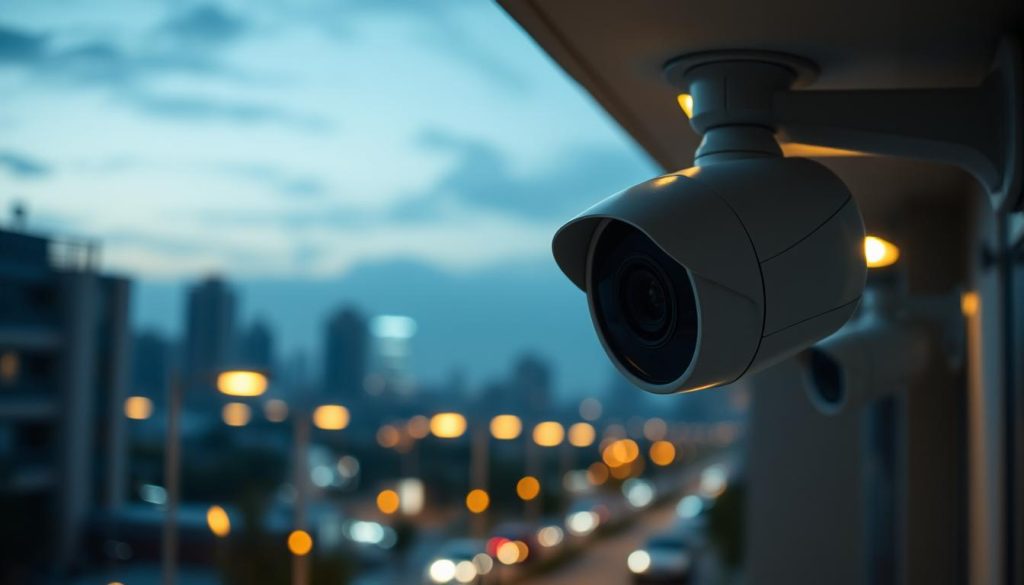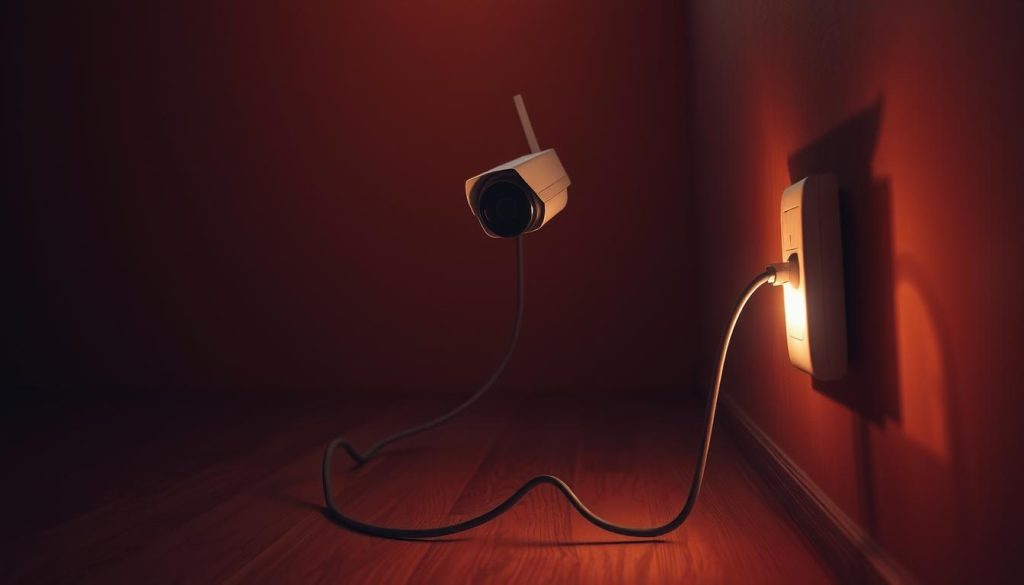It’s important to know how much CCTV electricity consumption is in Singapore. The monthly CCTV power usage can raise your energy bills, mainly if you have many cameras running all day. Different things affect the cost, like the camera type, its features, and setup.
By understanding these, you can make your CCTV energy efficiency better. This helps you manage your Singapore CCTV power needs more effectively.
Key Takeaways
- Knowing the average electricity consumption helps control monthly energy expenses.
- The type of CCTV camera significantly impacts power usage.
- Features like resolution and operational modes can increase energy consumption.
- Understanding your electric bill can lead to more informed decisions regarding CCTV systems.
- Improving energy efficiency can lead to long-term savings on operational costs.
Understanding CCTV Power Needs
When picking a CCTV system, knowing how much power it needs is key. Different CCTV cameras use different amounts of power. Knowing this helps manage energy better and save money.
Types of CCTV Cameras and Their Power Consumption
There are many types of CCTV cameras, each with its own power use. Basic IP cameras use 3 to 10 watts, great for homes. Analog cameras also use about the same amount. But, PTZ cameras can use up to 15 watts.
This affects both your energy bills and how well the system works.
How Features Impact Power Usage
Features in CCTV systems can change how much power they use. For example, high-definition cameras use more power than standard ones. Night vision, which uses infrared, also uses more power.
Knowing these details helps figure out how much energy a system will use.
Factors Affecting Electricity Usage
It’s key to know what affects CCTV power use to save on electricity. Several things impact how much power these systems use. The camera type, how long it runs, and the recording modes chosen all play a part.
Camera Types and Their Wattage
Each CCTV camera type uses different amounts of power. PTZ cameras need more energy because of their moving parts. This makes them less efficient than fixed cameras. Wired systems use less power than wireless ones because they don’t need to send energy through the air.
Choosing the right camera based on its wattage helps avoid wasting power. This ensures you get the best system for your needs without spending too much on electricity.
Operational Time and Recording Modes
How long CCTV cameras run affects their energy use. Cameras on 24/7 use more power than those only on during certain hours. The recording modes also impact power use.
Continuous recording and live streaming use more energy than modes that only turn on when there’s movement. Knowing this helps users manage their systems better and save energy.
Typical Power Consumption of Common CCTV Setups
CCTV setups vary a lot in power use. This depends on the camera type and its features. Knowing these differences helps in choosing the right security and energy-saving options.
Basic IP Cameras
Basic IP cameras are popular for home and small business security. They are affordable and easy to set up. These cameras use about 3 to 10 watts of power.
This means they use around 2.1 to 7.2 kWh each month. This makes them a good choice for saving on energy costs while keeping your place safe.
Bullet CCTV Cameras
Bullet CCTV cameras are sleek and capture clear video in many conditions. They usually use 4 to 8 watts of power. This means they use about 2.9 to 5.8 kWh each month.
They offer good power efficiency while providing reliable surveillance. This makes them a solid choice for many users.
PTZ Cameras
PTZ cameras are great for flexible monitoring needs. They can pan, tilt, and zoom, but use more power. They average 8 to 15 watts.
This results in a monthly use of 5.8 to 10.8 kWh. This requires careful thought for those balancing performance with energy costs.
Estimating Monthly Costs
To figure out monthly costs for CCTV systems, you need to do some math. First, find out how much power each camera uses. This means calculating the kilowatt-hours (kWh) each device uses in a month. You do this by multiplying the camera’s wattage by how many hours it runs.
Calculating Kilowatt-Hours Used Per Camera
For instance, a 5-watt camera running 24 hours a day uses about 3.6 kWh in a month. This simple math is key for planning your budget. Knowing how much energy your cameras use helps you budget better.
Understanding Your Electric Bill
After figuring out the kWh used, you need to look at your electric bill. Multiply the kWh by your local electricity rates to find the cost. This detailed look helps you estimate CCTV energy costs and make smarter choices about your security system.
Practical Tips for Reducing Energy Costs
Using smart strategies can greatly help cut down CCTV energy costs. Making the right choices and using the right methods ensures security. It also promotes sustainability and lowers energy bills.
Choosing Energy-Efficient Cameras
When picking out surveillance systems, look for energy-efficient cameras. Cameras that use Power over Ethernet (PoE) use less electricity. They last longer and are better for the environment.
Choosing these cameras can save you money in the long run.
Utilizing Motion Detection Features
Motion detection in CCTV systems can save a lot of energy. It lets cameras turn on only when there’s movement. This cuts down on power use.
Adjusting settings to better use motion detection can also help. These steps together make a solid plan for saving energy and money.
Comparing CCTV Cameras: Energy Efficiency
When looking at CCTV options, energy efficiency is key. Wired and wireless systems have their own pros and cons when it comes to power use. Knowing these differences helps you choose wisely, balancing your budget and environmental goals.
Wired vs. Wireless Systems
Wired systems are often more energy-efficient. They get a steady power supply, which means less energy waste. This can save you money on electricity bills.
But, wired setups might be less flexible. Wireless systems, on the other hand, offer more freedom in where you can place them. Yet, they might need batteries or wireless signals, which can affect their efficiency. This could lead to higher costs over time.
Energy Star Ratings and Their Importance
Choosing cameras with high Energy Star ratings can save you a lot of energy. These ratings show that the cameras use less power and waste less energy. This can help lower your electricity bills and keep your surveillance effective.
For those looking for something new, solar-powered wireless CCTV cameras are worth checking out. They offer both flexibility and sustainability, making them a great choice for energy-conscious users.

Weighing Costs: Is Your Security Worth It?
When you think about getting a CCTV system, it’s not just about the price. You need to look at how it will help keep you safe. Knowing the costs helps you see if it’s worth it.
Looking at CCTV system costs shows you both direct and indirect costs. It helps you see if the security is worth the money.
Cost Analysis of CCTV Systems
Getting a CCTV system can cost a lot at first. But, you also have to think about the ongoing costs like energy and upkeep. Experts say the long-term benefits of these systems are worth it. They help make places safer and reduce theft.
- Initial investments: This includes buying cameras, installing them, and getting the right accessories.
- Ongoing costs: Things like electricity and maintenance fees add up over time.
- Potential savings: Better security might even lower your insurance costs.
Deciding on a CCTV system should be based on how well it works. Weighing the benefits against the costs helps you make a smart choice.
How much electricity does CCTV use per month?
The amount of electricity CCTV systems use each month changes. This depends on the types and number of cameras. It’s important to look at how camera settings, recording modes, and features affect energy use. These factors add up to the total wattage, which is key when cameras run for long hours.
Calculating Average Monthly Power Consumption
To figure out monthly power use, start by finding out the wattage for each camera. Add these wattages together to get the total. Then, multiply this total by how many hours the cameras run each month. This will give you an estimate of kilowatt-hours used. By using local electricity rates, you can find out the monthly cost of running these cameras.
Understanding Seasonal Variations in Power Usage
Power usage changes a lot with the seasons. For example, winter nights are longer, so cameras record more. This can make energy costs go up during winter. Changing camera settings to fit these seasonal changes can help save money.
Innovations in CCTV Power Management
The world of CCTV systems is always changing. New ways to save energy are leading the way. Now, power management has improved a lot, cutting down energy use without losing surveillance quality.
Low-power parts have made cameras work better while using less power. This is great for today’s security needs.
There’s also a new trend in saving energy in CCTV systems. Better software helps cameras use less power when not needed. This means they only use full power when recording is important.
Solar-powered CCTV options are also becoming popular. They are good for the environment and work well for those who care about green security.
These new power management technologies are changing how we think about security. They make installations easier with Power over Ethernet (PoE). This keeps performance high without losing reliability.
This focus on saving energy is key. It helps cut costs and supports a sustainable future in surveillance.

